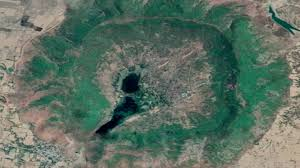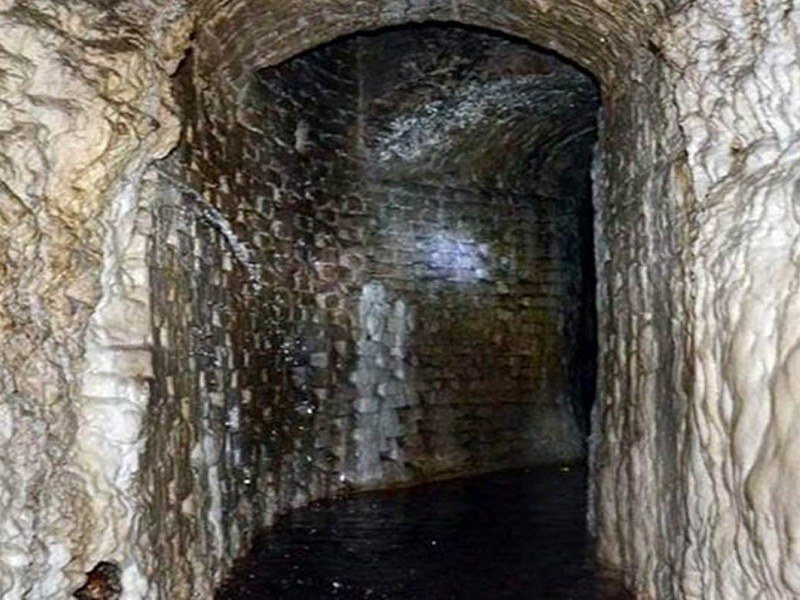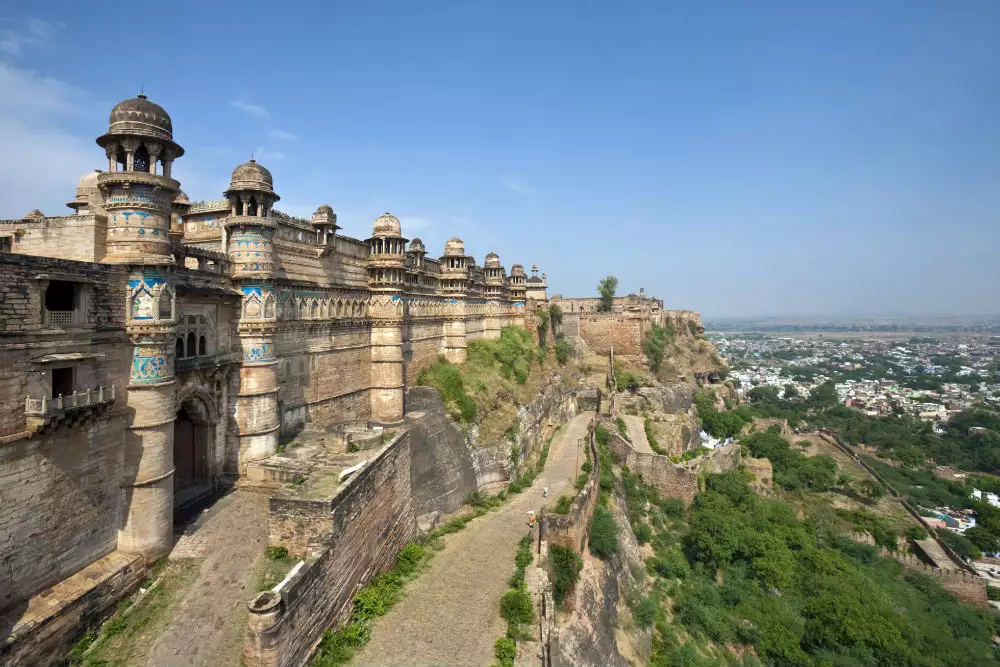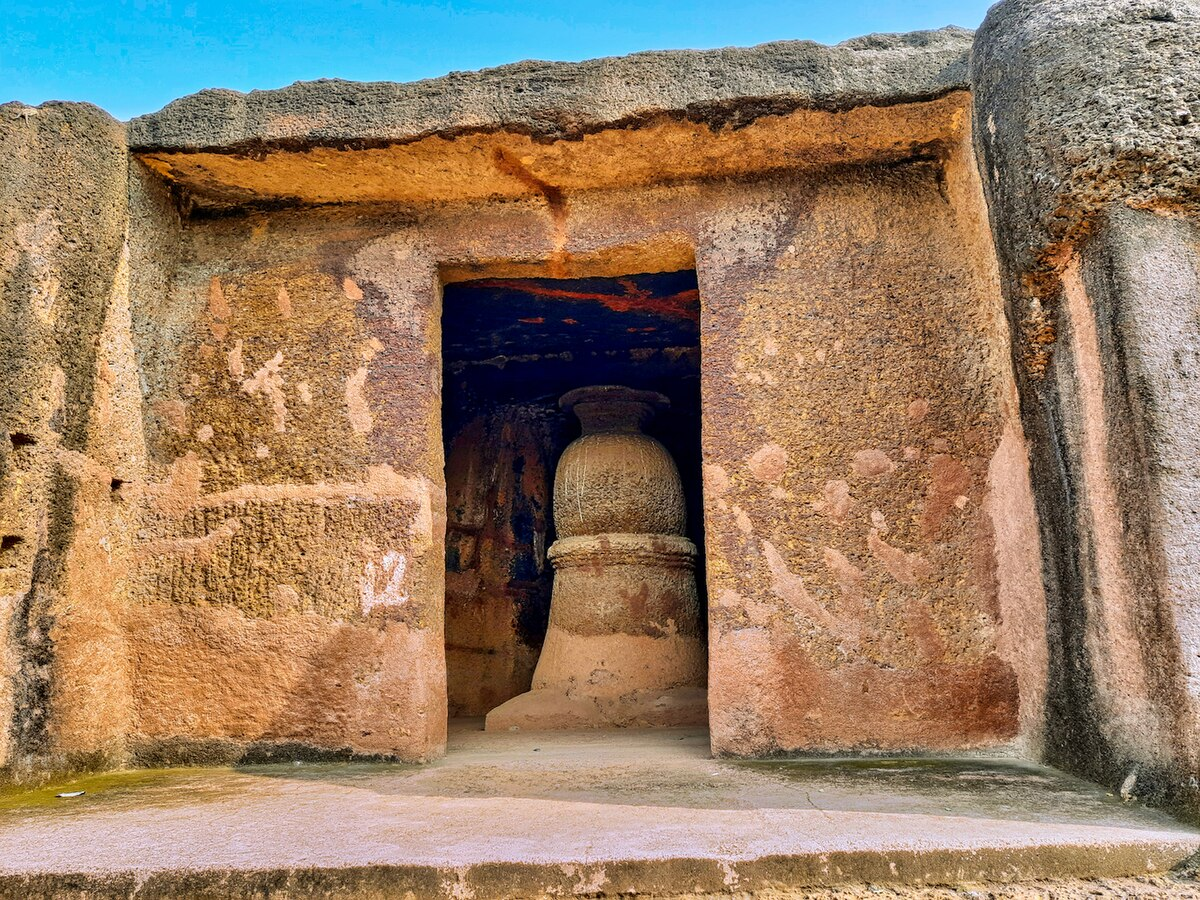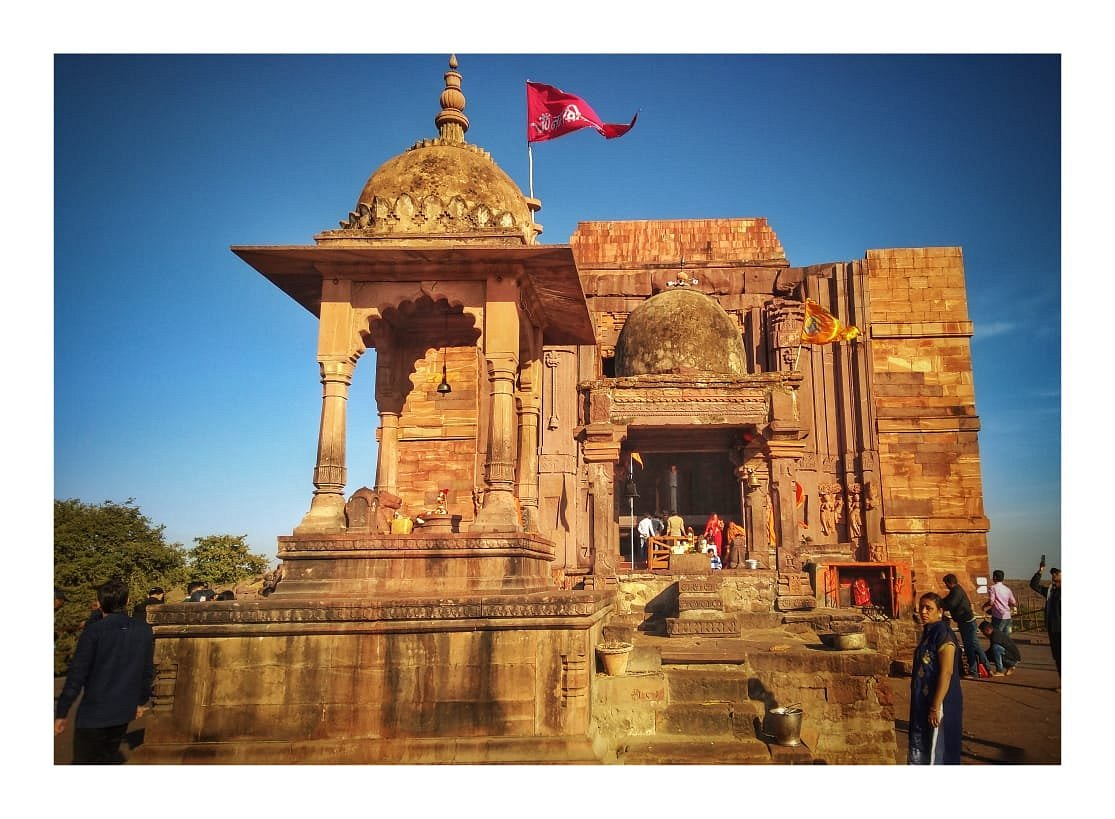Rajasthan Switch to Hindi
Rajasthan Recognizes Ramgarh Crater as India's 1st Geo-Heritage Site
Why in News?
Recently, the Rajasthan government officially recognised the 3-km diameter Ramgarh Crater at Baran district formed 165 million years ago due to a meteor impact, as the country's first Geo-Heritage Site.
Key Points
- Ramgarh Crater is significant for its ecosystem services, biodiversity, cultural, and heritage value for the local communities and society.
- This significance is reflected by its status as a declared Conservation Reserve, namely Ramgarh Conservation Reserve, under the Wildlife (Protection) Act, 1972.
- According to the State Wetland Authority, Pushkar Talab located inside the crater is a source of both saline and alkaline water, adding to the beauty and diversity of the area.
- These lakes have been notified as wetlands under the Wetland (Conservation & Management) Rules, 2017.
- Ramgarh Crater exhibits an important interchange of human values within a cultural area, reflected in developments in architecture or technology, monumental arts, town-planning,or landscape design.
- Bhand Deva Temple, influenced by Chandela dynasty and their temples at Khajuraho, is an example of such interchange.
- Its construction on a meteor impact crater adds to its uniqueness and significance.
Ramgarh Crater
- It is a meteor impact crater of 3.5 kilometres diameter in Kota plateau of Vindhya range located adjacent to Ramgarh village in Baran district in Rajasthan.
- It is formally accepted as the third crater in India, its diameter size would be between the two already confirmed craters in India - Dhala in Madhya Pradesh with 14 km diameter and Lonar in Buldhana district of Maharashtra with 1.8 km diameter.
Wildlife (Protection) Act, 1972
- It provides a legal framework for the protection of various species of wild animals and plants, management of their habitats, regulation, and control of trade in wild animals, plants, and products made from them.
- The act also lists schedules of plants and animals that are afforded varying degrees of protection and monitoring by the government.
- India's entry to the CITES (Convention on International Trade in Endangered Species of Wild Fauna and Flora) was made easier by the Wildlife Act.
- Earlier, Jammu and Kashmir was not covered by the Wildlife Protection Act of 1972. The Indian Wildlife Protection Act now applies to J&K as a result of the reorganisation act.
Uttar Pradesh Switch to Hindi
Uttar Pradesh to Install 100 Telemetric Weather Stations to Monitor Drought
Why in News?
Uttar Pradesh government announced plans to establish Telemetric Weather Stations (TWS) to monitor drought situation in the 100 most drought-prone tehsils in the State, including all tehsils in the seven districts of Bundelkhand region.
Key Points
- The initiative aims to combat the persistent drought conditions in Uttar Pradesh, after knowing the temperature, solar radiation, wind speed etc of the various locations in the state through TWS.
- It will be strategically placed at a distance of 7-10 kilometres from existing Automatic Weather Stations (AWS) and Automatic Rain-Gauge Stations (ARG), in spaces measuring 10 x 10 metres.
- Hamirpur, Banda, Lalitpur, Jalaun, Jhansi, Mahoba and Chitrakoot districts comprise the Bundelkhand region which faces challenges of drought every year.
- Automatic Weather Station (AWS): The automated type of conventional weather station and it is used to monitor weather in remote areas or when manpower is insufficient.
- Automatic Rain-Gauge Stations (ARG): Defined as a “meteorological station at which observations are made and transmitted automatically.
Jharkhand Switch to Hindi
Jharkhand Announces Free Bags For Students
Why in News?
Recently, the Jharkhand government announced to provide school bags to around 37 lakh students enrolled in Classes I to VIII in the state-run schools besides the books and other logistics provided to them as part of the school kit each year.
Key Points
- The announcement was made after the Chief Minister chaired a Cabinet meeting before the Election Commission announced the schedule for the Lok Sabha elections.
- A total of 53 proposals were taken up during the Cabinet meeting, most of which comprised road projects, irrigation and water supply works, rural development.
- The Government will provide a one-time refilling of gas cylinders per anganwadi every three months.
- To set up the Jharkhand Millet Mission Rs. 50 crore was approved.
- The government aims to expand the area under millet cultivation from the present, 40,000 hectares to 5,00,000 hectares over the next five years.
- Rs. 80 crore were sanctioned under the Kisan Samriddhi Yojana, which aims to provide solar based irrigation facilities to the farmers.
Note
The Government of Jharkhand is promoting Millets specially Ragi (Finger Millet) which is grown in the state in a very scattered manner. Due to the high nutritive value the State Government is promoting millets under State livelihood Policy which is under the Department of Panchayat, and is mostly served in midday meal for school children & hospitals.
Jharkhand Switch to Hindi
Jharkhand CM Lays Foundations of Degree Colleges
Why in News?
Recently, Jharkhand Chief Minister inaugurated the foundation stone laying for a new degree college in Chaibasa’s Hatgamharia and Bandgaon, enhancing education in West Singhbhum under Kolhan University.
Key Points
- The Chief Minister laid the foundation stone of 135 schemes at a cost of over Rs 2 billion, 31 crore, while the inauguration of 27 schemes worth over Rs 1 billion 7 crore was completed.
- Assets worth over Rs 1 billion 72 crore were distributed among beneficiaries.
- The introduction of the degree colleges under Kolhan University is expected to significantly impact the region’s educational landscape.
- This initiative aligns with the state’s broader objectives of promoting higher education and facilitating accessible educational opportunities for its youth.
- Teaching of tribal and regional languages like Kudukh, Ho, Mundari and Santhali is being started from primary schools.
- According to the Chief Minister many schemes have been started by the government to strengthen the education system of the state.
- To ensure that children’s education is not interrupted due to financial constraints, the scholarship amount has been increased three times.
- Girl students are being linked to Savitribai Kishori Savitri Yojana.
- Through the Guruji Credit Card Scheme, education loans up to Rs 15 lakh are being given to students for pursuing courses like medical engineering.
- Under the Manki Munda Scholarship Scheme, financial assistance is being given to girl students for technical education.
- The state government is giving 100% scholarship to the tribal, Dalit, minority and backward class students for higher education abroad.
Savitribai Kishori Savitri Yojana
- It aims to emphasize on girl education, ending child marriage and women empowerment.
- Under this scheme, adolescent girls have to be enabled to take independent decisions regarding their lives.
- Under this the state government is giving assistance of Rs 40,000 to adolescent girls for good education.
- Rs 2500 will be given to girl students in class 8, Rs 2500 in class 9, Rs 5000 in class 10, Rs 5000-5000 in class 11th and 12th and Rs 20,000 to adolescent girls on completion of 18 to 19 years.
- In this way, a total of 40 thousand rupees will be given to the adolescent girls.
Guruji Student Credit Card Scheme
- This scheme was launched on 14th March, 2024 by the Jharkhand government.
- Under the Guruji Student Credit Card Scheme, students will get a maximum loan of Rs 15 lakh. A maximum of 30% of this amount will be available for non-institutional work (including living and food expenses).
- Students will have to pay a simple rate of interest of 4%. The rest of the interest will be paid by the state government in the form of interest subvention.
- Students will not need to give any kind of collateral security to take a loan. Students will be able to repay the loan amount in 15 years.
- The interest on the loan that the children will take will be calculated at the rate of simple interest. It will remain fixed for the entire tenure of the loan.
Manki Munda Scholarship Scheme
- This scheme was launched on 14th March, 2024, by the Jharkhand government
- Under the Manki Munda Scholarship scheme, girl students will receive Rs 15,000 per annum for diploma courses and Rs 30,000 per annum for engineering courses.
Bihar Switch to Hindi
Bihar’s Greenhouse Gas Emission to Rise Five Times by 2070
Why in News?
According to the ‘Climate Resilient and Low-Carbon Development Pathway’ report, Bihar’s greenhouse gas emission is projected to increase 5.2 times by 2070, when India targets to achieve net zero emission.
Key Points
- The findings were in the report drafted by the Bihar State Pollution Control Board (BSPCB) in association with the United Nations Environment Programme.
- The government of Bihar had initiated the process to prepare the strategy for a climate resilient and low-carbon development pathway in February 2021.
- The draft report states that:
- Bihar’s contribution to national emissions is about 3.3% of India's greenhouse gas emissions in 2018, lower than its share of national population (8.8%), even as they had doubled between 2005 and 2013.
- The energy sector was the highest emitter of greenhouse gases with a contribution of 69% to the total in 2018, followed by agriculture, forest and other land use at 24%, waste management with 5% and industrial processing and product use at 2%.
- If present trend continues, the state’s emissions are projected to increase 5.2 times between 2020 and 2070.
- The energy sector will continue to be the highest emitter, projected to contribute 93% of the total emissions. Followed by construction (6%), transport (5%) and industries (5%).
- The dominance of the power sector in emissions is because of the continued dependence on coal for electricity generation.
- Since most emissions are from the power sector, Bihar will need to avoid opening new thermal power plants after 2030 to be consistent with India’s net zero 2070 target.
- Therefore, the state will need to secure long-term clean energy power purchase agreements with renewable energy-rich states.
- In addition, the state will need to consider options like rooftop solar panels, floating solar, agri-photovoltaics and other decentralised forms of renewable energy proactively.
- At the same time, end-use sectors of industry, transport and real estate will need to be electrified so that emissions from them are reduced through use of renewable energy.
United Nations Environment Programme (UNEP)
- It is a leading global environmental authority established on 5th June 1972.
- It sets the global environmental agenda, promotes sustainable development within the United Nations system, and serves as an authoritative advocate for global environment protection.
Net Zero Emission
- It is referred to as carbon neutrality, which does not mean that a country would bring down its emissions to zero.
- It is a state in which a country’s emissions are compensated by the absorption and removal of greenhouse gases from the atmosphere.
- More than 70 countries have promised to become Net Zero by the middle of the century i.e., by 2050.
- India has promised to cut its emissions to net zero by 2070 at the conference of parties-26 (COP) summit.
Madhya Pradesh Switch to Hindi
Six Madhya Pradesh Heritage Sites Included in Tentative UNESCO List
Why in News?
Recently, six heritage sites in Madhya Pradesh have been included in the tentative United Nations Educational, Scientific and Cultural Organization (UNESCO) list.
Key Points
- The sites included in the new list included Gwalior Fort, the Historical Group of Dhamnar, Bhojeshwar Mahadev Temple, Rock Art Sites of Chambal Valley, Khooni Bhandara, Burhanpur, and God Memorial of Ramnagar, Mandla.
- In 2010 efforts were started to include the underground water structure Khooni Bhandara in the list of UNESCO's World Heritage.
- In 2013, a UNESCO team came to see this structure. All the shortcomings pointed out by them were rectified.
- Now the district administration, municipal corporation administration and Madhya Pradesh government have prepared an action plan to provide facilities here.
Khooni Bhandara
- It is an underground water management system comprising eight waterworks built in the historical city of Burhanpur in Burhanpur district of Madhya Pradesh.
- These Mughal period waterworks of Burhanpur form one of the most significant historic water systems in India.
- Built on a similar Persian qanat approach as also in the existing historic towns of Aurangabad and Bidar these water systems in Burhanpur were constructed in 1615 CE.
Gwalior Fort
- The Gwalior Fort is a hill fort near Gwalior, Madhya Pradesh. The fort has existed at least since the 10th century, and the inscriptions and monuments found in the fort indicate that it may have existed as early as the beginning of the 6th century.
- It has been held by many dynasties like the Hunas, the Gurjara – Pratiharas, the Kachchhapaghatas, the Tomars, the Lodis and the Mughals.
- The Fort contains several temples and structures.
Historical Group of Dhamnar
- The Dhamnar caves are located on a hill near the village of Dhamnar in the Mandsaur district of Madhya pradesh.
- This rock cut site consists of a total of 51 caves of varying sizes carved into the laterite hill.
- The hill consists of two groups of structures, the series of Buddhist caves and the hindu temple complex known as the Dharmarajeshwara temple, also called Dharmanath temple.
Bhojeshwar Mahadev Temple
- The Bhojeshwar Temple is an incomplete Hindu temple in Bhojpur village of Madhya Pradesh.
- The temple's construction is believed to have started in the 11th century, during the reign of the Paramara king Bhoja.
- The construction was abandoned for unknown reasons, with the architectural plans engraved on the surrounding rocks.








%20MPPCS%202025%20Desktop%20E.jpg)
%20MPPCS%202025%20Mobile%20E%20(1).jpg)










.png)
.png)











 PCS Parikshan
PCS Parikshan